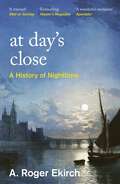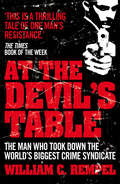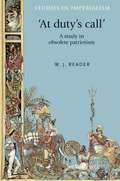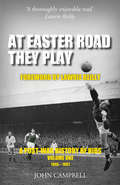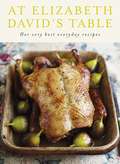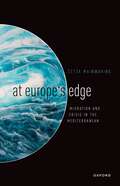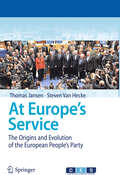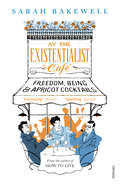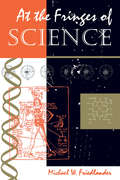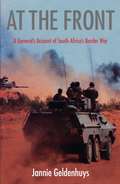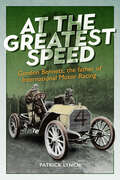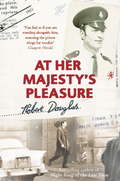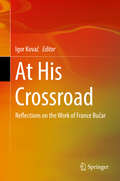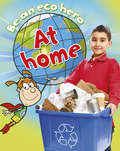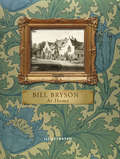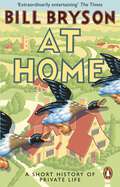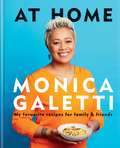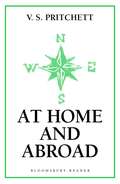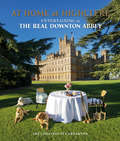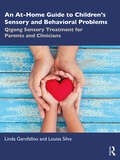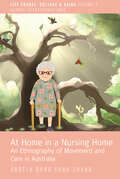- Table View
- List View
At Day's Close: A History of Nighttime
by A. Roger EkirchA fascinating and colourful social history of the nighttime in the pre-Industrial era.AT DAY'S CLOSE charts a fresh realm of Western culture, nocturnal life from the late medieval period to the Industrial revolution. The book focuses on the cadences of daily life, investigating nighttime in its own right and resurrecting a rich and complex universe in which persons passed nearly half of their lives - a world, long-lost to historians, of blanket fairs, night freaks, and curtain lectures, of sun-suckers, moon-cursers and night-kings. It is not only the vocabulary that has disappeared, AT DAY'S CLOSE will restitute many facts which have been either lost or forgotten. It is a significant and newsworthy contribution to social history, filled with substantial research, stories and new discoveries.Ekirch uses a wide range of sources to reconstruct how the night was lived in the past : travel accounts, memoirs, letters, poems, plays, court records, coroner's reports, depositions and laws dealing with curfews, crime and lighting. He has analysed working-class autobiographies, proverbs, nursery rhymes, ballads and sermons, and folklore, as well as consulting medical, psychological and anthropological papers.
At The Devil's Table: Inside the fall of the Cali cartel. The world's biggest crime syndicate
by William C. RempelAN IMPOSSBLE CHOICEJorge Salcedo was trapped. For years, he had climbed the ladder inside the Cali drug cartel, the world's most powerful crime syndicate, and risen to Head of Security. But he'd kept clean, avoided the dirty work, managed to sleep at night. Until now. He'd finally received the order he'd long dreaded, and it meant one thing: kill or be killed. THE HARD WAYSalcedo was a family man, a man with a conscience, a father - he was no cold-blooded murderer. He was left with the last resort. It meant risking his life, his family's life, and the lives of everyone he cared for. He would have to take the whole syndicate down. It was the price to pay for salvation.WOULD YOU RISK YOUR LIFE TO SAVE YOUR SOUL?
'At Duty's Call': A study in obsolete patriotism (Studies in Imperialism #5)
by W. J. ReaderThe Victorian private solider was a despised figure. A working man had to be desperate indeed to take the Queen’s shilling. Yet in the first sixteen months of the Great War two and a half million men from the UK and many more from the empire, flocked to the colours – without any form of legal compulsion. There had never been a volunteer army like it. What was in the air of England in the generation or so before 1914 to bring about such collective exultation? How did it come about that, in a society which – in oft-proclaimed contrast to Germany – rejected conscription and prided itself on having no taint of militarism, men could be induced to volunteer in such numbers? The nation’s general state of mind, system of values and set of attitudes derived largely from the upper middle class, which had emerged and become dominant during the nineteenth century. The book examines the phenomenon of 1914 and the views held by people of that class, since it was under their leadership that the country went to war.
At Easter Road they Play: A Post-War History of Hibs, Volume 1
by John CampbellSince 1875 Hibernian Football Club has been an integral part of sporting life in the City of Edinburgh and Port of Leith; its early history up to 1946 has been brilliantly documented in The Making of Hibernian trilogy by Alan Lugton. John Campbell's At Easter Road they Play is the first part of a new trilogy that brings the history up to date, picking up the story from 1946 and covering what was the most successful part of the club's history when Hibernian won three Championship titles and became the first British club to play in the European Cup, reaching the semi-final. Packed with anecdotal tales of the times, it gives a fascinating insight into life at the club when the Famous Five were in their heyday right through to the mid-sixties when a young lad by the name of Joe Baker burst onto the scene. A game-bygame, goal-by-goal account of the many highs and numerous lows, At Easter Road they Play takes the reader on a fantastic journey back to the days when massive crowds flocked to Easter Road to see Hibernian play. For any Hibs fan that lived through those heady days this book will bring back to life a host of happy memories whilst at the same time allowing those fans who were perhaps too young or not even born at the time to see just how different football was back then when compared to the modern day game.
At Eden’s Door: The Habsburg Jewish Life of Leon Kellner (1859-1928) (The Littman Library of Jewish Civilization)
by David RechterLeon Kellner was part of the intellectual and cultural elite of imperial Austria. Engaged in politics, a member of his regional parliament, and an essayist of repute, he was also a Zionist leader and confidant of Theodor Herzl. He created an institution for Jews’ cultural, educational, and social advancement modelled on London’s Toynbee Hall, which spread across east-central Europe to great effect. He was also an internationally recognized Shakespeare scholar. Yet for all this, today he is little known.How did someone born into a lower-middle-class Orthodox Jewish family from the province of Galicia come to gain such prominence in the Habsburg empire? Kellner’s is a thoroughly Habsburg Jewish story, spanning east and west and shaped by the empire’s history, politics, and culture. He was a singular character: a Galician Jew at home in Vienna and in Czernowitz, eyes towards Zion, yet content also in London, and never more so than when absorbed in the minutiae of Shakespeare’s texts. Kellner’s world was destroyed twice over: Habsburg Austria came to an end in 1918, east-central European Jewry in 1945. This biography recovers at least part of what was lost.
At Elizabeth David's Table: Her Very Best Everyday Recipes
by Elizabeth DavidAt Elizabeth David's Table is the very best from the woman who who changed the face of British cooking. Elizabeth David introduced a dreary post-war Britain to the sun-drenched culinary delights of the Mediterranean; to foods like olive oil and pasta, artichokes and fresh herbs - foods that have become the staples of our diets today. Her recipes brought colour and life into kitchens everywhere, yet her books never contained any photographs. Now, published for the first time, is this beautiful new collection of her most inspiring, everyday recipes with full-colour photography throughout.Published to celebrate the 60th anniversary of Elizabeth's first book, At Elizabeth David's Table has twelve chapters guiding the reader from tasty soups and starters, through to meat, fish and desserts. Sections on successful bread making, as well as more extravagant dishes, ensure that this will become the cookery bible that you will turn to, time and time again. Interspersed throughout At Elizabeth David's Table are some of Elizabeth's short essays - from how to cook 'fast and fresh' using store cupboard ingredients, to evocative portraits of French and Italian markets.'Not only did she transform the way we cooked but she is a delight to read' Express on Sunday 'Britain's most inspirational food writer' Independent 'When you read Elizabeth David, you get perfect pitch. There is an understanding and evocation of flavours, colours, scents and places that lights up the page' Guardian 'Not only did she transform the way we cooked but she is a delight to read' Express on Sunday Elizabeth David (1913-1992) is the woman who changed the face of British cooking. Having travelled widely during the Second World War, she introduced post-war Britain to the sun-drenched delights of the Mediterranean and her recipes brought new flavours and aromas into kitchens across Britain. After her classic first book Mediterranean Food followed more bestsellers, including French Country Cooking, Summer Cooking, French Provincial Cooking, Italian Food, Elizabeth David's Christmas and At Elizabeth David's Table.
At Europe's Edge: Migration and Crisis in the Mediterranean
by Ċetta MainwaringThe Mediterranean Sea is now the deadliest region in the world for migrants. Although the death toll has been rising for many years, the EU response remains fragmented and short sighted. Politicians frame these migration flows as an unprecedented crisis and emphasize migration control at the EU's external boundaries. In this context, At Europe's Edge investigates why the EU prioritizes the fortification of its external borders; why migrants nevertheless continue to cross the Mediterranean and to die at sea; and how EU member states on the southern periphery respond to their new role as migration gatekeepers. The book addresses these questions by examining the relationship between the EU and Malta, a small state with an outsized role in migration politics as EU policies place it at the crosshairs of migration flows and controls. The chapters combine ethnographic methods with macro-level analyses to weave together policymaker, practitioner, and migrant experiences, and demonstrate how the Mediterranean is an important space for the contested construction of 'Europe'. This book provides rich insight into the unexpected level of influence Malta exerts on EU migration governance, as well as the critical role migrants and their clandestine journeys play in animating EU and Maltese migration policies, driving international relations, and producing Malta's political power. By centring on the margins, the book pushes the boundaries of our knowledge of the global politics of migration, asylum, and border security.
At Europe's Edge: Migration and Crisis in the Mediterranean
by Ċetta MainwaringThe Mediterranean Sea is now the deadliest region in the world for migrants. Although the death toll has been rising for many years, the EU response remains fragmented and short sighted. Politicians frame these migration flows as an unprecedented crisis and emphasize migration control at the EU's external boundaries. In this context, At Europe's Edge investigates why the EU prioritizes the fortification of its external borders; why migrants nevertheless continue to cross the Mediterranean and to die at sea; and how EU member states on the southern periphery respond to their new role as migration gatekeepers. The book addresses these questions by examining the relationship between the EU and Malta, a small state with an outsized role in migration politics as EU policies place it at the crosshairs of migration flows and controls. The chapters combine ethnographic methods with macro-level analyses to weave together policymaker, practitioner, and migrant experiences, and demonstrate how the Mediterranean is an important space for the contested construction of 'Europe'. This book provides rich insight into the unexpected level of influence Malta exerts on EU migration governance, as well as the critical role migrants and their clandestine journeys play in animating EU and Maltese migration policies, driving international relations, and producing Malta's political power. By centring on the margins, the book pushes the boundaries of our knowledge of the global politics of migration, asylum, and border security.
At Europe's Service: The Origins and Evolution of the European People's Party
by Thomas Jansen Steven Van HeckeThe European People's Party, the largest political party in Europe, has roots that run deep in history. Founded in 1976 as a Christian Democratic federation, the European People's Party is now a strong centre-right movement and a leading European political family. It has member parties in almost all European countries, and it is very well represented in the institutions of the European Union. This book tells the story of the European People's Party: why it was founded, how it is currently organised and what its guiding ideas, values and principles are. It gives an up-to-date account of the party's contribution to European integration, its work with its member parties and its central role in organising the centre-right in Europe. Above all, this book is for everyone who wants to know what a European-level political party looks like, how it is structured and how it acts.
At The Existentialist Café: Freedom, Being, and Apricot Cocktails
by Sarah BakewellShortlisted for the PEN Hessell-Tiltman PrizeParis, near the turn of 1932-3. Three young friends meet over apricot cocktails at the Bec-de-Gaz bar on the rue Montparnasse. They are Jean-Paul Sartre, Simone de Beauvoir and their friend Raymond Aron, who opens their eyes to a radical new way of thinking…‘It’s not often that you miss your bus stop because you’re so engrossed in reading a book about existentialism, but I did exactly that... The story of Sartre, Beauvoir, Camus, Heidegger et al is strange, fun and compelling reading. If it doesn’t win awards, I will eat my copy’ Independent on Sunday‘Bakewell shows how fascinating were some of the existentialists’ ideas and how fascinating, often frightful, were their lives. Vivid, humorous anecdotes are interwoven with a lucid and unpatronising exposition of their complex philosophy… Tender, incisive and fair’ Daily Telegraph‘Quirky, funny, clear and passionate… Few writers are as good as Bakewell at explaining complicated ideas in a way that makes them easy to understand’ Mail on Sunday
At The Fringes Of Science
by Michael W FriedlanderScientific discoveries are constantly in the news. Almost daily we hear about new and important breakthroughs. But sometimes it turns out that what was trumpeted as scientific truth is later discredited, or controversy may long swirl about some dramatic claim.What is a nonscientist to believe? Many books debunk pseudoscience, and some others present only the scientific consensus on any given issue. In At the Fringes of Science Michael Friedlander offers a careful look at the shadowlands of science. What makes Friedlander's book especially useful is that he reviews conventional scientific method and shows how scientists examine the hard cases to determine what is science and what is pseudoscience.Emphasizing that there is no clear line of demarcation between science and nonscience, Friedlander leads the reader through case after entertaining case, covering the favorites of ?tabloid science? such as astrology and UFOs, scientific controversies such as cold fusion, and those maverick ideas that were at first rejected by science only to be embraced later.There are many good stories here, but there is also much learning and wisdom. Students of science and interested lay readers will come away from this book with an increased understanding of what science is, how it works, and how the nonscientist should deal with science at its fringes.
At The Fringes Of Science: With A New Epilogue
by Michael W FriedlanderScientific discoveries are constantly in the news. Almost daily we hear about new and important breakthroughs. But sometimes it turns out that what was trumpeted as scientific truth is later discredited, or controversy may long swirl about some dramatic claim.What is a nonscientist to believe? Many books debunk pseudoscience, and some others present only the scientific consensus on any given issue. In At the Fringes of Science Michael Friedlander offers a careful look at the shadowlands of science. What makes Friedlander's book especially useful is that he reviews conventional scientific method and shows how scientists examine the hard cases to determine what is science and what is pseudoscience.Emphasizing that there is no clear line of demarcation between science and nonscience, Friedlander leads the reader through case after entertaining case, covering the favorites of ?tabloid science? such as astrology and UFOs, scientific controversies such as cold fusion, and those maverick ideas that were at first rejected by science only to be embraced later.There are many good stories here, but there is also much learning and wisdom. Students of science and interested lay readers will come away from this book with an increased understanding of what science is, how it works, and how the nonscientist should deal with science at its fringes.
At The Front: A General's Account Of South Africa's Border War
by Jannie GeldenhuysGeneral Jannie Geldenhuys is widely regarded as one of the leading military commanders South Africa has produced. As Chief of the South African Defence Force from 1985 to 1990, he brought his experience to bear on the Border War in Namibia, and was part of the negotiating team that brought an end to the conflict in 1989. In this completely revised and updated edition, Geldenhuys reflects on a military career spanning more than four decades. At the Front covers the years before and during the protracted Border War, and consists of Geldenhuys' personal experiences and insights. He sheds light on the final years of the conflict and the negotiated settlement, and also writes of his early years, as he evolved from a rugby-mad young officer to a deep-thinking, reflective man with ever-sharpening insights into war, peace, politics and, most of all, himself.
At The Greatest Speed: Gordon Bennett, the Father of International Motor Racing
by Patrick LynchJames Gordon Bennett was born in 1841, a spoilt only son who took over as publisher of the New York Herald from his millionaire father. Bennett tirelessly supported pioneering fields of technology and sport, always with speed in mind. In 1899, fascinated by the new motor cars, he instigated the International Gordon Bennett Cup. The inaugural race took place in 1900 between Paris and Lyon. Three countries entered, but this was just the beginning of a massive phenomenon that, thanks to Bennett, saw spectators grow from less than a hundred to eighty-thousand. The widespread anti-car sentiment, endless bureaucracy, speed limits, safety and design challenges were all obstacles to overcome. Each Gordon Bennett Cup Race is documented here with an account of the drivers, the cars, the courses and the thrilling highs and lows of the events. The 1903 Cup, which was held in Ireland, was crucial since for the very first time a closed-circuit course was used. It was also the first international race in the British Isles. His dedicated promotion of early motor-car racing gave a boost to the global auto-industry and was a firm basis to the international racing that is still a thrilling part of our lives over 100 years later.
At Her Majesty's Pleasure
by Robert DouglasIn the final instalment in his autobiographical trilogy, Robert Douglas takes us through the sixties and into the eighties with his memories of life as a prison officer, and, at the end of his career, as an electricity chargehand driving around the Yorkshire Dales. He tells us of his prison experiences, with anecdotes about many of the most famous criminals in British history -- the Krays, the Richardsons, the Great Train Robbers, Soviet spies and many more. Told in the same endearing and fascinating voice that readers of LAST SONG OF THE NIGHT TRAM and SOMEWHERE TO LAY MY HEAD first fell in love with, this volume continues the story of Robert's remarkable journey of self-education, introducing us to larger-than-life characters on both sides of the bars, and evoking a strong sense of social change as Britain emerged from the post-War gloom into the bright lights of the Beatles years.
At His Crossroad: Reflections on the Work of France Bučar
by Igor KovačThis book is a translation and celebration of Slovenian politician France Bučar’s seminal work. Divided into two parts, the book first contains several studies of Bučar’s arguments. As Bučar applied his system theory to a variety of issues, so too the conglomerate of scholars and issues critically assessed is interdisciplinary, ranging from political science and economics, to law and philosophy, as well as to natural sciences. The contributors and the questions of their essays in the edited volume are as follows. Peter Verovsek (University of Sheffield) examines different branches of Critical Theory and classifies Bučar within them. Mark Hamilton (Inter-American Defense College) discusses system dynamics of Bučar’s system theory. Urška Velikonja (Georgetown University) applies Bučar’s system theory to the question of the ethics, rules, and regulations in financial economics. Finally, Matej Drev (Georgia Institute of Technology) connects Bučar to the issue of artificial intelligence and inequality.The second part is the English translation of Bučar’s book At A New Crossroads, which addresses the role of ethics in society. Bučar normatively redefines national identity as the crux of his novel understanding of ethics. Using system theory, he addresses the problems of globalization and governance, presenting a post-modern synthesis of the logic of free flow of capital and global citizenship, with national and cultural identity. Speaking to contemporary society, he shows how society and ethical life are reproduced. Bučar provides the reader with new tools to think about national identity and global politics. Bringing an important work on ethics, government, and identity to an entirely new readership, this book will appeal to a broad academic audience, namely students and practitioners in the fields of economics, social sciences, and humanities.
At Home (Be an Eco Hero #1)
by Susan BarracloughFind out how you can be an eco hero at home! Learn how to save energy and water, and how to reduce, reuse and recycle your waste. This colourful book for children features large photographs and engaging superhero children characters that are illustrated in a cartoon style.
At Home: A short history of private life (Bryson Ser. #3)
by Bill BrysonWhat does history really consist of? Centuries of people quietly going about their daily business - sleeping, eating, having sex, endeavouring to get comfortable. And where did all these normal activities take place? At home.This was the thought that inspired Bill Bryson to start a journey around the rooms of his own house, an 1851 Norfolk rectory, to consider how the ordinary things in life came to be. And what he discovered are surprising connections to anything from the Crystal Palace to the Eiffel Tower, from scurvy to body-snatching, from bedbugs to the Industrial Revolution, and just about everything else that has ever happened, resulting in one of the most entertaining and illuminating books ever written about the history of the way we live, enhanced in this new edition by hundreds of stunning photographs and illustrations.
At Home: A Short History of Private Life (Bryson #3)
by Bill BrysonIn At Home, Bill Bryson applies the same irrepressible curiosity, irresistible wit, stylish prose and masterful storytelling that made A Short History of Nearly Everything one of the most lauded books of the last decade, and delivers one of the most entertaining and illuminating books ever written about the history of the way we live. Bill Bryson was struck one day by the thought that we devote a lot more time to studying the battles and wars of history than to considering what history really consists of: centuries of people quietly going about their daily business - eating, sleeping and merely endeavouring to get more comfortable. And that most of the key discoveries for humankind can be found in the very fabric of the houses in which we live.This inspired him to start a journey around his own house, an old rectory in Norfolk, wandering from room to room considering how the ordinary things in life came to be. Along the way he did a prodigious amount of research on the history of anything and everything, from architecture to electricity, from food preservation to epidemics, from the spice trade to the Eiffel Tower, from crinolines to toilets; and on the brilliant, creative and often eccentric minds behind them. And he discovered that, although there may seem to be nothing as unremarkable as our domestic lives, there is a huge amount of history, interest and excitement - and even a little danger - lurking in the corners of every home.
At Home: My favourite recipes for family & friends
by Monica GalettiMonica Galetti's career has taken her from her home in Samoa and New Zealand to the professional kitchens of London. Her new cookbook, At Home, showcases the easy, everyday dishes she enjoys at home, with family and friends, using simple ingredients that everyone will enjoy. From breakfast time and midweek suppers to celebrations, gatherings and the perfect Sunday lunch.CONTENTSChapter one: Chilled-Out BreakfastsIncluding Banana waffles; Eggs Benedict with Sriracha Hollandaise and Masi Samoa - Samoan ShortbreadChapter two: WeeknightsIncluding Spring Onion Tempura with Soy & Garlic Dipping Sauce; Sweetcorn Fritters with Horseradish Cream and Apple & Blackberry BakeChapter three: The Perfect SundayIncluding Walnut, Blackberry & Feta Salad; Pork Shoulder with Pistachio Stuffing and Beer-Battered Fish & Rosemary Salt ChipsChapter four: Family Get TogethersIncluding Steak, Chimichurri & Burnt Butter Mash; Aubergine & Anchovy Pizza and Lemon & White Chocolate Baked AlaskaChapter five: Holiday FavouritesIncluding Olive Tapenade with Wholemeal Flatbreads; Manuka & Ras el Hanout Roast Lamb and Chocolate Brandy Snaps with Orange Marmalade Chantilly
At Home and Abroad
by V. S. PritchettAdmirers of The Spanish Temper, Marching Spain and his wonderfully evocative books on London, Dublin and New York will need no reminding that V.S. Pritchett is one of the very great travel writers of our time, possessed of an astonishingly accurate eye and a marvellous ability to conjure up the essence of a place, and of the people who live there. Written for the most part in the 1950s and 1960s, the essays brought together in At Home and Abroad cover South and North America, Spain, Ireland, Portugal, London, Greece, the Pyrenees, Germany, the English countryside and, above all, the Mediterranean: first published in book form in 1990, the year of Sir Victor's ninetieth birthday, they are a delight in themselves and a timely reminder of - or introduction to - this most subtle and perceptive of writers.
At Home at Highclere: Entertaining at The Real Downton Abbey
by Lady Carnarvon'A gorgeous book with beautiful photos, and a historical document to boot.' - Steve Wright, BBC Radio 2Lady Carnarvon’s love of history is richly rewarded at Highclere Castle with its mine of family records going back some 300 years. She has delved into the archives to create a book that invites you inside the Castle, past and present. Throughout the centuries, Highclere has welcomed Royalty, Statesmen, Egyptologists and pioneers of technology along with men and women from the worlds of music, art and letters. The etiquette of the invitation, the balance of guests at a weekend house party, their ‘placement’ at dinners, and the entertainment of friends, as well as the domestic management required to execute the perfect occasion, have all preoccupied successive generations of châtelaines. This book tells the story four real life weekends - from 1866 to 1936 - when the great and the good gathered at Highclere to change the world in some large or small part. It then reflects on how the current Countess entertains 'At Home' at Highclere today. Each weekend showcases the life of the house, both upstairs with the rich and famous and below stairs with the staff and employees. You are transported to a world where guests were collected from the long since defunct Highclere Station in carriages or later in the earliest cars having had the train stop specifically for them and where the allocation of the most prestigious bedrooms really did matter. It looks at what should be served for dinner, the hot topics of conversation and gossip, traditional breakfasts and shooting parties with the Prince of Wales. She explores how menus were, and still are now, put together with the chef, what were the de rigueur cocktails of the day (and why) – and how to make them at home wherever you are. Each chapter will explore some of the recipes and, where practical, have adaptations and photos of the recipes which can be cooked in today’s kitchens. Many recipes are little-changed to this day and Lady Carnarvon shares her commentary on their context at Highclere.‘Highclere works hard to steer a steady course in today’s world, but the Castle was built for entertainment and pleasure, for convivial weekends. I hope this book gives a glimpse inside a great house, with mouth-watering recipes, eye-catching photographs and fascinating stories about some of the remarkable people who have stayed here.’ – Lady Carnarvon
An At-Home Guide to Children’s Sensory and Behavioral Problems: Qigong Sensory Treatment for Parents and Clinicians
by Linda Garofallou Louisa SilvaAn At-Home Guide to Children’s Sensory and Behavioral Problems gives a new perspective on sensory and behavior problems, one that sees those behaviors as stemming from a child’s immature sensory nervous system and regulation difficulties. This book offers an effective at-home intervention, the Qigong Sensory Treatment, that enlists a parent's attuned touch to address often overlooked sensory issues that underlie ‘problem’ behaviors and works to organize those sensory experiences to foster connection and the capacity for self-regulation. It introduces the reader to a new and clinically useful model to understand sensory development, the Early Childhood Self-regulatory Milestones which are critical to the emotional and behavioral health and regulation for all children. With clear step-by-step instructions, diagrams, and links to online instructional videos, it teaches parents how to successfully implement the daily QST hands-on routine. Unique to the treatment model is how it guides and focuses parents to easily recognize, interpret and respond to their child's shifting non-verbal body and behavioral responses and cues. An extensive workbook section navigates parents through a year-long process of learning and implementing QST at home. Weekly letters include those written by the authors, parents who share their own personal experiences with the routine and by QST Master Trainers who offer their years of experience and helpful tips. The 52 letters are timed to anticipate and answer typical questions or stumbling blocks that parents commonly encounter at key points, guiding them to success with their child’s sensory and behavior difficulties while making for happier and less-stressful times with their child. This guide will be indispensable to parents and clinicians looking to understand and more effectively work with their child’s developmental difficulties.
An At-Home Guide to Children’s Sensory and Behavioral Problems: Qigong Sensory Treatment for Parents and Clinicians
by Linda Garofallou Louisa SilvaAn At-Home Guide to Children’s Sensory and Behavioral Problems gives a new perspective on sensory and behavior problems, one that sees those behaviors as stemming from a child’s immature sensory nervous system and regulation difficulties. This book offers an effective at-home intervention, the Qigong Sensory Treatment, that enlists a parent's attuned touch to address often overlooked sensory issues that underlie ‘problem’ behaviors and works to organize those sensory experiences to foster connection and the capacity for self-regulation. It introduces the reader to a new and clinically useful model to understand sensory development, the Early Childhood Self-regulatory Milestones which are critical to the emotional and behavioral health and regulation for all children. With clear step-by-step instructions, diagrams, and links to online instructional videos, it teaches parents how to successfully implement the daily QST hands-on routine. Unique to the treatment model is how it guides and focuses parents to easily recognize, interpret and respond to their child's shifting non-verbal body and behavioral responses and cues. An extensive workbook section navigates parents through a year-long process of learning and implementing QST at home. Weekly letters include those written by the authors, parents who share their own personal experiences with the routine and by QST Master Trainers who offer their years of experience and helpful tips. The 52 letters are timed to anticipate and answer typical questions or stumbling blocks that parents commonly encounter at key points, guiding them to success with their child’s sensory and behavior difficulties while making for happier and less-stressful times with their child. This guide will be indispensable to parents and clinicians looking to understand and more effectively work with their child’s developmental difficulties.
At Home in a Nursing Home: An Ethnography of Movement and Care in Australia (Life Course, Culture and Aging: Global Transformations #9)
by Angela Rong ZhangFocusing on contemporary ideas about how aged care is provided, this book poses the question: How can people who are aged and frail live out the final phase of their lives with dignity? In seeking answers, the author examines what it means to be ‘at home’ in residential care in a novel and compassionate way. In an ethnographic study of how elderly residents can be given the right care, this book provides a new route into the bodily realities of ageing. It is a vital contribution to the search for alternative approaches to aged care provision.
